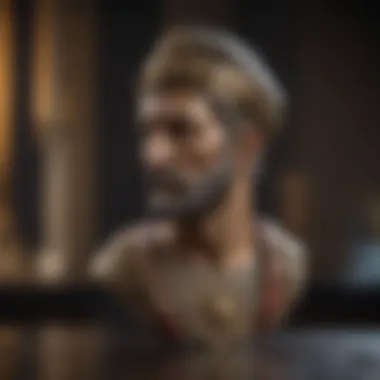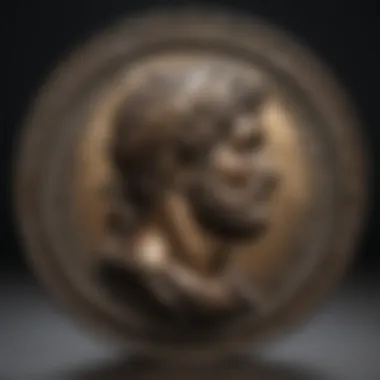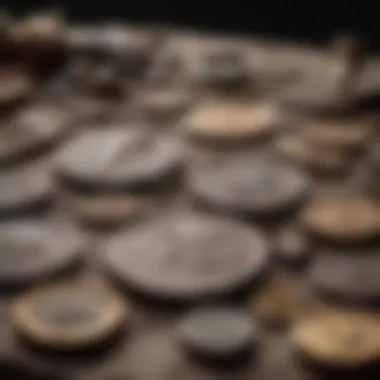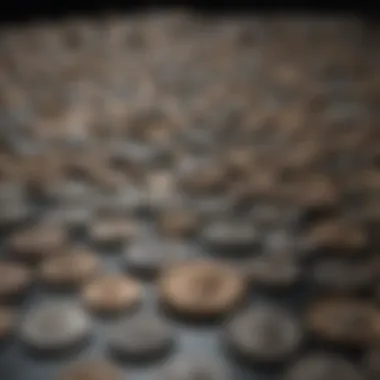Unveiling the Intriguing Universe of Ancient Roman Coins


Roman Coins Overview
Welcome to the captivating world of Roman coins! Throughout history, Roman coins have held immense historical significance and artistic value. By exploring the process of minting these ancient artifacts and delving into the different types of Roman coins, we unlock a treasure trove of knowledge that captivates enthusiasts and scholars alike.
Understanding the Minting Process
The minting process of Roman coins is a fascinating journey that reveals the artistry and precision of ancient craftsmen. From preparing the blank coin discs to striking the designs with intricate details, every step in minting a Roman coin is a testament to the skill and creativity of the time.
Types of Roman Coins
Roman coins come in various types, each with its unique designs and historical significance. From denarii to aureii, ases to dupondii, exploring the different types of Roman coins unveils a diverse range of images, inscriptions, and symbols that offer insights into the culture, politics, and rulers of ancient Rome.
Significance and Thrill of Collecting
Collecting Roman coins is not just a hobby; it's a way to connect with history and hold a piece of the past in your hands. The thrill of discovering a rare coin, tracing its origins, and adding it to your collection is an experience like no other. Whether you collect for historical interest or the joy of owning a piece of art, Roman coins never cease to fascinate and inspire.
Relevance of Roman Coins Today
Despite being ancient artifacts, Roman coins continue to be relevant today, serving as valuable historical records and timeless pieces of art. Studying Roman coins offers insights into the economic, political, and cultural aspects of the Roman Empire, making them not just collectibles but educational tools that bridge the gap between the past and the present.
Prolusion
The realm of Roman coins stands as a testament to ancient history, offering a fascinating journey into the past intricacies of monetary systems and cultural symbols. This article serves as a comprehensive guide for enthusiasts and scholars, unveiling the exceptional significance of Roman coins in understanding our historical heritage.
Unveiling the Treasures of History
Origins of Roman Coinage
Delving into the origins of Roman coinage reveals a pivotal moment in the development of monetary practices. The inception of Roman coins traces back to the utilization of precious metals, symbolizing economic prowess and societal advancements. The distinct characteristic of Roman coinage origins lies in their role as a medium of exchange, portraying the evolution of trade and commerce in ancient civilizations. Understanding the beginnings of Roman coinage provides a foundation for grasping its transformative influence on the economic landscape.
Evolution of Roman Coins
The evolution of Roman coins showcases a progression in design and craftsmanship, reflecting the political and cultural shifts throughout history. From simple geometric patterns to intricate engravings of rulers and deities, Roman coins exemplify the artistic prowess of ancient mints. The key characteristic of this evolution is the transition from functional currency to artistic expression, highlighting the Roman Empire's technological advancements and aesthetic sophistication. Exploring the evolution of Roman coins unveils a narrative of innovation and creativity embedded in numismatic traditions.
Artistry and Symbolism
Design Aesthetics


Investigating the design aesthetics of Roman coins unravels a tapestry of visual narratives, blending precision and creativity in metal form. The intricate details etched on each coin evoke a sense of craftsmanship and cultural symbolism, reflecting the artistic sensibilities of ancient artisans. The key characteristic of Roman coin design lies in its ability to convey historical events and mythological tales through visual elements, captivating collectors and historians alike. Exploring the design aesthetics of Roman coins offers a glimpse into the artistic evolution of numismatic artistry.
Symbolic Meanings
The symbolic meanings embedded in Roman coins transcend mere currency value, embodying the ideology and beliefs of the Roman Empire. Each symbol engraved on a coin carries a deeper significance, ranging from political propaganda to religious iconography. The key characteristic of symbolic meanings on Roman coins is their power to communicate social values and historical narratives, providing insights into the cultural landscape of ancient Rome. Decoding the symbolic meanings behind Roman coins enriches the numismatic experience with layers of allegory and significance.
Historical Significance
Economic Impact
The economic impact of Roman coins extends beyond their monetary value, shaping trade networks and financial systems across the ancient world. Roman coins functioned not only as legal tender but also as instruments of imperial power and economic stability. The key characteristic of their economic impact lies in their role as symbols of Roman authority and wealth, influencing commerce and diplomatic relations. Exploring the economic implications of Roman coins unveils a complex web of financial interactions and policy decisions that sculpted the economic landscape of the Roman Empire.
Cultural Influence
The cultural influence of Roman coins permeates various aspects of ancient society, reflecting artistic trends, religious beliefs, and political ideologies. The imagery depicted on Roman coins captures the essence of Roman culture, showcasing portraits of emperors, gods, and mythological figures. The key characteristic of cultural influence in Roman coins is their capacity to preserve historical narratives and societal values through numismatic artifacts. Examining the cultural context of Roman coins provides a window into the diverse cultural tapestry woven by the ancient Romans.
The Thrill of Collection
Rare Finds
Unearthing rare Roman coins excites collectors with the allure of unique historical artifacts and numismatic discoveries. Rare finds offer enthusiasts the opportunity to acquire pieces of antiquity that embody stories of empires and civilizations long past. The key characteristic of rare Roman coins lies in their scarcity and historical significance, driving collectors to explore ancient hoards and archaeological sites. Embracing the thrill of discovering rare Roman coins adds a layer of excitement and intrigue to the world of numismatics.
Authentication Challenges
Navigating the authentication challenges of Roman coins presents collectors with a puzzle of provenance and historical accuracy. Distinguishing genuine coins from forgeries requires expertise and analytical techniques, safeguarding collectors from misattributed or counterfeit pieces. The key characteristic of authentication challenges is the meticulous process of scrutinizing coin details, from inscriptions to mint marks, to validate their authenticity. Overcoming authentication hurdles in Roman coin collection requires a keen eye for detail and a deep understanding of numismatic principles, ensuring the integrity of ancient artifacts in a market rife with replicas and replicas.
Types of Roman Coins
The exploration of types of Roman coins is a crucial aspect of understanding the fascinating world of these ancient artifacts. Delving into denominations sheds light on the historical context, artistic value, and diversity within Roman coinage. Recognizing the significance of Aureus, Denarius, and Sestertius in this article provides a comprehensive overview that appeals to both enthusiasts and scholars seeking profound insights into Roman numismatics.
Denominations
Aureus
In the realm of Roman coins, Aureus holds a prestigious status for its impeccable craftsmanship and unparalleled value. The intrinsic allure of Aureus lies in its high gold content, symbolizing wealth and power during the Roman era. Its compact size and intricate design make it a sought-after choice among collectors and investors alike. However, Aureus' scarcity poses a challenge for enthusiasts, considering its limited availability and premium pricing in the market.
Denarius
Denarius, known for its silver composition, serves as a significant contributor to the broader narrative of Roman coinage. The accessibility of Denarius, coupled with its widespread circulation during ancient times, makes it a popular inclusion in numismatic collections. Its iconic depiction of Roman emperors and deities adds cultural and historical value, capturing the essence of Roman civilization. Despite its historical significance, the commonality of Denarius may impact its rarity and investment appeal.


Sestertius
Sestertius, distinguished by its large brass composition, plays a unique role in the spectrum of Roman coins. The substantial size of Sestertius allows for detailed engravings, showcasing intricate designs that reflect the artistic prowess of Roman craftsmen. While Sestertius offers a more affordable option for collectors compared to gold or silver coins, its bulkiness and susceptibility to corrosion present challenges in long-term preservation. Understanding the nuances of Sestertius provides a holistic view of Roman coinage diversity and the practical considerations involved in collecting such relics.
Minting Process
In this section, we delve deep into the intricate Minting Process of Roman coins, a crucial aspect that defines their historical importance and numismatic significance. Understanding the Minting Process provides us with valuable insights into the craftsmanship and precision involved in creating these ancient marvels. From sourcing raw materials to the final striking of the coins, each step in the Minting Process contributes to the authenticity and value of Roman coins.
Materials and Techniques
Metal Composition
The Metal Composition of Roman coins plays a pivotal role in determining their durability, appearance, and collectible value. Typically crafted from precious metals like gold, silver, and bronze, the Metal Composition reflects the economic standards and artistic preferences of the Roman era. Gold coins symbolize wealth and power, silver coins signify commerce and prestige, while bronze coins cater to daily transactions and common folks. The unique feature of Metal Composition lies in its ability to withstand the test of time, preserving the historical narratives encapsulated within Roman coins.
Die-Stamping
Die-Stamping, an essential technique in the Minting Process, involves the creation of intricate designs and inscriptions on coin dies. These dies, crafted from hardened steel, imprint the desired images onto metal blanks, ensuring uniformity and precision in each coin struck. The key characteristic of Die-Stamping lies in its capacity to mass-produce coins with consistent details, facilitating widespread circulation and standardization of Roman currency. However, the disadvantage of Die-Stamping is the potential for die degradation over time, leading to variations in coin appearances.
Production Stages
Designing
The Designing stage of coin production focuses on conceptualizing and creating the visual elements that will adorn the coins. Skilled artisans meticulously craft intricate designs that reflect the political propaganda, religious symbolism, and cultural ethos of the Roman Empire. Each coin design carries a narrative, from depicting victorious emperors to commemorating significant events, offering a glimpse into the historical context of the era. The advantage of Designing is its ability to communicate complex ideas and ideologies through visual imagery, immortalizing them on miniature canvases.
Striking
Striking, the final stage in coin production, involves the forceful imprinting of designs onto metal blanks using heavy machinery. This process results in the formation of well-defined images and inscriptions on the coins, enhancing their aesthetic appeal and readability. The key characteristic of Striking is the creation of raised relief designs that provide a tactile experience for both the viewer and collector, adding depth and dimension to the coin's surface. Despite its advantages in producing detailed coins efficiently, the challenge of Striking lies in achieving consistent pressure and alignment to maintain quality standards.
Collecting and Preservation
In the multifaceted universe of Roman coins, the segment of Collecting and Preservation emerges as a crucial facet that demands meticulous attention and specialized knowledge. For enthusiasts and scholars alike, the act of collecting these ancient artifacts transcends mere acquisition; it embodies a profound connection to history and artistry. Preservation, too, plays a fundamental role in maintaining the integrity and value of these timeless relics. Exploring the realm of Collecting and Preservation unravels a tapestry of insights and challenges, offering a deep dive into the intriguing practices that enrich the experience of Roman coin aficionados.
Authentication Methods
Expert Examination
Delving into the domain of Expert Examination within the context of Roman coins presents a fascinating avenue for aficionados to validate the authenticity and historical context of their numismatic treasures. This method entails a thorough scrutiny by seasoned numismatists and historians, leveraging their expertise to unravel the intricate details embossed on these ancient pieces. Through expert examination, collectors can unravel the hidden stories behind each coin, deciphering clues embedded within the design and inscriptions. The meticulous scrutiny offered by expert examination ensures a rigorous verification process, elevating the credibility of the collected pieces. While this method showcases undeniable advantages in certifying the legitimacy of Roman coins, its reliance on human expertise may introduce subjective elements that require a discerning eye to navigate.


Scientific Analysis
Incorporating Scientific Analysis into the authentication process of Roman coins introduces a scientific dimension that complements the expertise-driven approach of expert examination. By employing advanced analytical techniques such as metal composition analysis, X-ray fluorescence, and carbon dating, collectors gain access to objective data that sheds light on the material composition, age, and production techniques employed in crafting these ancient artifacts. Scientific analysis offers a quantitative and empirical framework to substantiate claims regarding the authenticity and provenance of Roman coins, enhancing the overall confidence in the collected pieces. However, while scientific analysis provides invaluable data-driven insights, it may present certain limitations in interpreting the historical and cultural significance encapsulated within these numismatic treasures, underscoring the complementary roles of expertise and scientific methodologies.
Preservation Techniques
Storage Conditions
Navigating the intricacies of Preservation Techniques reveals a paramount consideration for collectors seeking to safeguard the longevity and quality of their Roman coin collections. Establishing ideal storage conditions is imperative to shield these delicate artifacts from environmental factors like humidity, temperature fluctuations, and oxidation. By opting for archival-quality materials and implementing controlled storage environments, collectors can mitigate the risks of corrosion and deterioration, preserving the aesthetic and intrinsic value of their prized possessions. The meticulous curation of storage conditions not only safeguards the physical integrity of Roman coins but also contributes to maintaining their historical and monetary worth, underscoring the foundational role of preservation in fostering a legacy of numismatic excellence.
Cleaning Practices
Embarking on the realm of Cleaning Practices unveils a nuanced approach to maintaining the pristine appearance and integrity of Roman coins. Adopting gentle cleaning methods and non-invasive techniques is paramount to prevent inadvertent damage or abrasions to the coin's surfaces. Isopropyl alcohol swabs, soft brushes, and gentle rinsing processes represent a subset of practices employed by discerning collectors to remove surface debris and pollutants without compromising the coin's original patina or engravings. By exercising caution and precision in cleaning practices, collectors can enhance the visual allure of Roman coins while retaining their historical allure and numismatic significance. However, a potential pitfall of intensive cleaning approaches resides in the risk of unintentional abrasions or alterations to the coin's surface, necessitating a delicate balance between preservation and restoration efforts.
Market Trends and Value
Market trends and value play a crucial role in this comprehensive guide on exploring the intriguing world of Roman coins. Understanding the dynamics of the market is key to gauging the worth and demand for these ancient artifacts. By analyzing market trends, collectors and enthusiasts can make informed decisions regarding acquisitions and sales. The value of Roman coins is influenced by various factors such as rarity, historical significance, and aesthetic appeal. Tracking market trends allows individuals to stay informed about pricing fluctuations, helping them navigate the ever-evolving landscape of numismatics.
Factors Influencing Prices
Condition
Condition stands out as a pivotal determinant of the value of Roman coins. The state of preservation, including wear and tear, can significantly impact the desirability and pricing of a coin. Collectors often seek coins in pristine condition, devoid of scratches or damage, enhancing their aesthetic and monetary value. Coins in excellent condition command higher prices due to their rarity and allure to serious numismatists. However, coins with some level of patina or aged appearance might also hold appeal for those interested in the historical authenticity they convey, creating a market niche for varying conditions.
Rarity
Rarity serves as another vital aspect shaping the worth of Roman coins. The scarcity of a particular coin type or design increases its desirability among collectors, inevitably leading to higher prices. Coins with limited mintage, unique historical significance, or uncommon features garner increased attention and investment interest. Rarity contributes to the excitement of coin collecting, as individuals avidly search for elusive and coveted pieces to enhance their collections. While rare coins hold substantial value, their scarcity also poses challenges in terms of availability and affordability for enthusiasts.
Investment Potential
Market Fluctuations
Examining market fluctuations is essential in assessing the investment potential of Roman coins. Like any commodity, the value of coins can fluctuate due to market conditions, economic factors, and collector trends. Understanding these fluctuations aids collectors in timing their purchases and sales for optimal returns. Monitoring market trends allows individuals to capitalize on opportunities and make strategic investment decisions, potentially yielding financial gains over time.
Long-term Prospects
Analyzing the long-term prospects of Roman coins offers insights into their enduring value and historical significance. While prices may fluctuate in the short term, coins with solid provenance, rarity, and demand tend to appreciate over time. Investing in Roman coins can provide not only financial rewards but also a deeper connection to ancient history and cultural heritage. By considering the long-term prospects of their numismatic acquisitions, collectors can build valuable portfolios that reflect their passion for antiquities and commitment to preserving a piece of the past.
Epilogue
In the expansive realm of Roman coins, the Conclusion serves as the culminating point of this detailed journey. It consolidates the essence of understanding Roman numismatics, emphasizing the value of preserving and appreciating these historical relics. As we unravel the intricate layers of Roman coinage, it becomes apparent that each piece is not just a representation of currency but a testimony to a bygone era. The Conclusion encapsulates the essence of the entire discourse, urging collectors and enthusiasts alike to delve deeper into the past and relish the legacy left behind by these ancient artifacts. It directs attention to the significance of historical preservation and the need for continued exploration of Roman coinage to maintain a connection with our rich cultural heritage.
Appreciating the Legacy
Delving into the depths of history, Appreciating the Legacy encompasses the essence of Roman coinage and its enduring impact on today's antiquities market. The legacy left behind by Roman coins transcends mere monetary value, reflecting the artistic mastery and cultural nuances of a civilization long gone. Each coin tells a unique story, a testament to the ingenuity of ancient craftsmen and the power dynamics of emperors. By appreciating the legacy of Roman coins, collectors gain a profound insight into the socio-economic fabric of the Roman Empire, unraveling tales of conquest, prosperity, and downfall etched in metal. It fosters a sense of connection with the past, bridging the gap between antiquity and modernity, offering a glimpse into the lives of those who once held these coins in their hands. Appreciating the Legacy invites collectors to immerse themselves in a world of wonder and intrigue, where each coin is not just a fragment of history but a gateway to a forgotten era.







